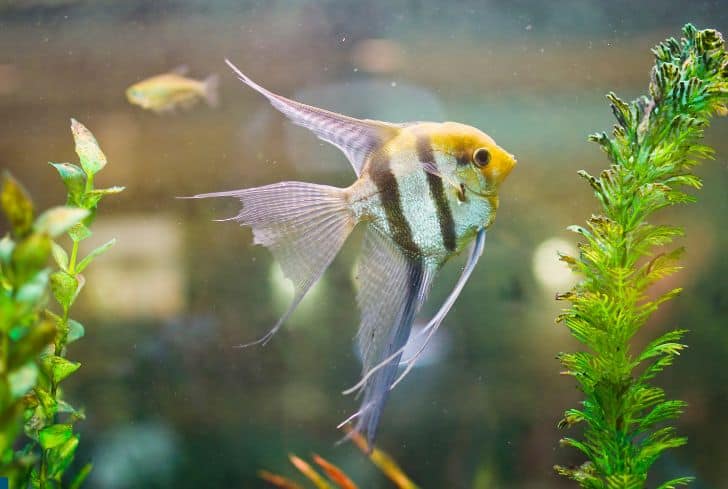15 Types of Fish With Legs And Can Walk (With Pictures)

When studying the anatomy of fish in school, did your teacher ever mention something to do with legs? Or fish that can walk?
I bet no.
That’s because, generally, even out of experience, fish don’t have legs. And it would be bizarre to even think of fish with legs because; why would they have legs when they spend their entire lives in water? (At least according to the knowledge engraved in our minds since we were kids).
However, the mysterious earth is full of wonders, and some species of fish have legs and can walk even out of water, to defy that phenomenon. Of course, this walking isn’t anything like a bipedal, but more of a quadrupedal style.
Curious to learn about the strange creatures? We’ve compiled a list of 15 types of fish with legs that can walk.
But just before we dive in…
About Fish With Legs
How?
Well, the legs of these fish typically are pectoral fins, which have, over time, evolved.
That’s not surprising, as according to scientists, the four-limbed vertebrates you see on earth today evolved from an ancient type of fish.
Worthy legs, the fins-turned legs help these fish walk in the water and on land. So they don’t exist only to make the fish strange. They give these fish two benefits over their legless counterparts,
including;
Diversified feeding
Fish with legs can walk out of the water to forage on the land. Those restricted to aquatic life, can use their legs to hold into the bottom of their environment where food is plenty.
Better defense mechanisms
The fish have the luxury to move out of the water to flee from aquatic predators and swim back to water if threatened by land-dwelling animals. The legs also help the fish blend in, holding onto bottom-water items in their environment to hide from predators.
Without further ads, let’s dive in.
Types of Fish With Legs
1. Red-lipped Batfish

The Red-lipped batfish is one of the oddest sea creatures you can find. It belongs to anglerfish, but unlike other members, this species takes its unusual traits to extreme lengths.
As a bottom-dweller, Red-lipped batfish is adapted to the environment with its four thin pseudo legs. Thanks to these legs, the fish can perch and walk on sandy reefs on the ocean floor to leverage its feeding. And, interestingly, the legs suit walking more than they suit swimming (they’ve got an awkward swimming style).
The unusual traits of this fish don’t stop with the legs. They have a mixture of colors, with light-brown bodies, white stomachs, and dark brown dotted stripes on the top from the head to the tail. And living up to its name, the lips are bright red to make the fish look like it has just worn bright red lipstick! According to scientists, the fish uses its lips to attract mates.
Where to find Red-lipped batfish; all year round in the Galapagos Islands in the Pacific Ocean
2. Mudskippers

Mudskipper is an umbrella name for at least 25 species of small tropical fish from the Oxudercinae family. They love roaming muddy waters, especially rivers and swamps.
While all species are unique, generally, the fish have notable blunt heads and characteristic large, movable protruding eyes.
If not weirder than Red-lipped batfish, mudskippers are equally strange fish.
The curiosity of these crazy-looking fish makes them want to explore life outside the water. And guess what? They have what it takes.
Their powerful pectoral fins are more like legs, allowing the fish to walk in mud in a crutching style. Meanwhile, their gills can trap air for survival out of water. And unlike your usual fish, mudskippers can breathe through the skin! That’s why the fish have the luxury of spending a significant amount of time on land.
Not for just walking on mud, the muscular legs mudskippers enable them to perch on rocks and mangrove roots, waiting for prey on insects, worms, and small crustaceans.
Where to find mudskippers; they inhabit subtropical regions in Australia, Africa, and Asia.
3. Lungfish
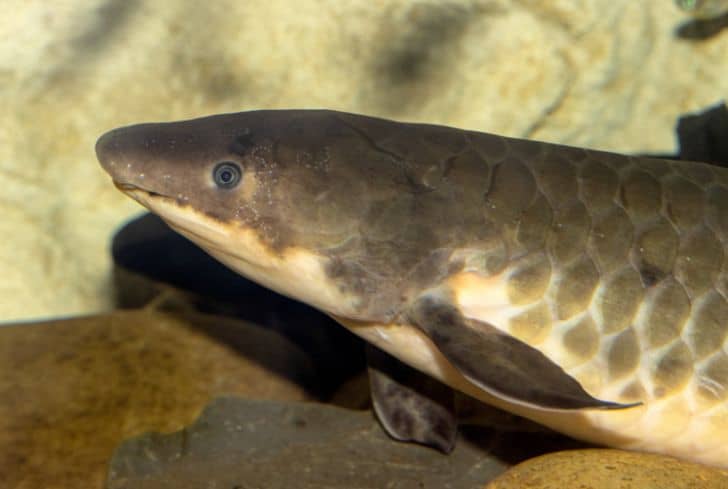
Lungfish encompasses a group of at least six fish species from the Protopteridae family. They’re some of the most primitive fish you can find.
According to Science Daily, the fins of lungfish are a perfect example of how fins evolved into legs.
The African lungfish, for example, lives in freshwater habitats, in small rivers and swamps. But it’s not without some odd, fascinating adaptations that make them just as comfortable out of water.
The fins of this African species have evolved into thin hind limbs to walk across sea beds and to propel the fish out of water. It’s a unique fish with two lungs to breathe air, like other vertebrates.
4. Frogfish
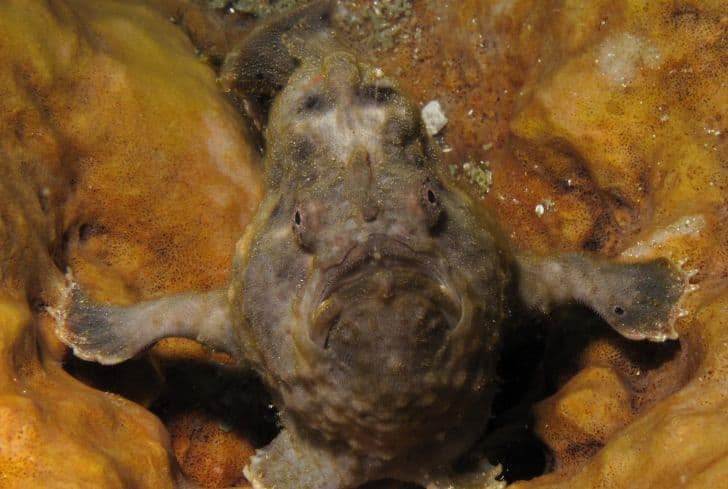
Frogfish is a group of about 60 species of small, stocky fish from the Antennariidae family.
Like the Red-lipped batfish, members of the frogfish family have their pectoral fins evolved into legs with walking capabilities.
According to Pietsch, a fish expert at Burke Museum of Natural History and Culture, frogfish can walk like a four-legged land animal. And unlike many fish on our list, frogfish does its antics in water, walking and hopping to access the bottom sea and over coral and rocks.
Fun fact: frogfish can change their coloration to any color you can ever think!
Where to find frogfish; shallow subtropical and tropical waters worldwide
Types of Fish That Can Walk Without Legs
Even without real legs, some species can walk. Some use their hand-like fins, and others walk with typical pectoral fins.
Some strange species use their entire bodies.
5. Handfish

Handfish is a group of small, uncommon species of fish that share the anglerfish family with frogfish.
Like their distant cousins, handfish prefer to walk in water rather than swim – after all, they are bad swimmers.
And although they lack legs, their pectoral fins have evolved to look like oversized hands, enabling the tiny sea creatures to walk effortlessly across ocean floors. But like mudskippers and lungfish, handfish lack lungs, so their walking is limited to water bodies.
However, the mysterious handfish may not be around for long, as several of them, including the spotted handfish, Ziebell’s handfish, and the red handfish, are critically endangered due to habitat destruction and pollution.
Where to find handfish; they predominantly live in Tasmanian, in Southern Australia.
6. Polypterus Bichir
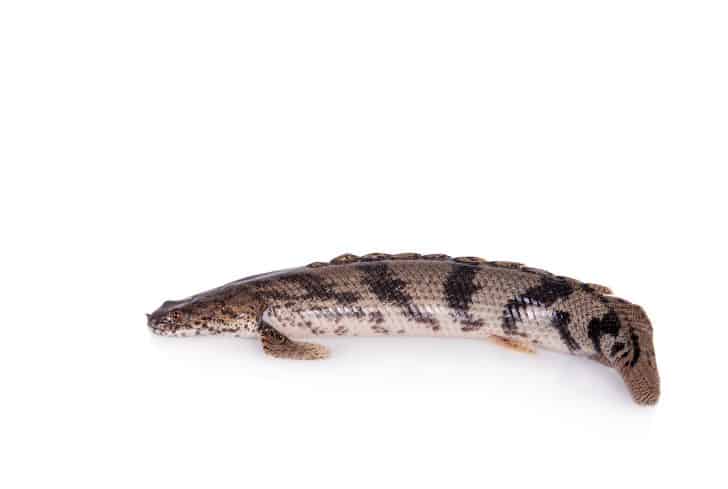
Also called Nile bichir, Polypterus bichir is a large fish with a flat head and cylindrical body shape from the polypteridae family.
The eel-like fish is so mysterious that while it neither has legs nor hand-like fins, it exhibits similar walking traits to tetrapods. It uses pectoral fins, positioned strategically like a lizard’s legs. The bichir walks only across the shallow waters of small rivers and pounds where it lives.
And while the bichir cannot walk on land, it can breathe in the open air because it has a pair of lungs that gulp oxygen when the fish is close to the water’s surface.
Where to find the Polypterus bichir: shallow water and slow-moving rivers in the Nile basin and lake Turkana
7. Tiktaalik Roseae

Well, Tiktaalik roseae is an extinct fish, but we’ve included it because it displayed walking characteristics during its time on earth 375 million years ago.
Growing up to about 3 meters long, this giant of a fish had powerful fins which functioned just like limbs in tetrapods, as fossil remains reveal.
It was an entirely aquatic creature, swimming in the water, but didn’t shy away from walking on riverbeds and mudflats.
8. The Red Gurnard

The red gurnard is a long-bodied fish with a large mouth, and belongs to the triglidae family.
The strange-looking fish has many more exceptional characteristics than any other fish.
From the pectoral fins, some spines have undergone modification to look and function like legs. Meanwhile, the rest of the pectoral fins mimic butterfly wings, and the fish uses them for defense as well as courting mates.
And while the pseudo legs of the red gurnard help the fish walk across the ocean floor, they have a unique adaptation: they possess chemoreceptors to allow the fish to feel its way and smell food around.
9. Epaulette Shark

Epaulette shark is a long, slender fish with a characteristic eye-like spot above the pectoral fin. Across the shark’s body are widely spaced black spots.
According to a study by Florida Atlantic University and Australian collaborators, the Epaulette shark has all it takes to walk in and out of the water at will. While it lacks legs to pull off this strange behavior, it moves by wiggling its body with the help of paddle-shaped fins. That’s probably the most awkward movement style of fish that can walk.
The researchers suggest that little sharks learned how to walk from some individuals of the same species when they moved to a new area.
10. Walking Catfish
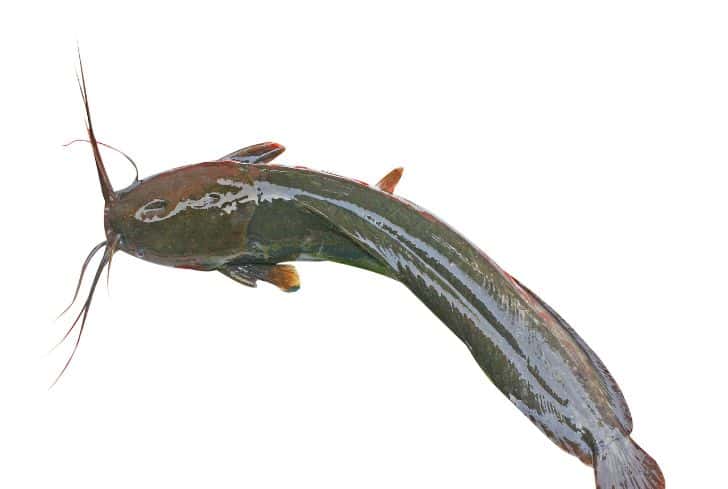
The walking catfish is native to the freshwater habitats of Asia.
This fish is not different from other catfishes, as it also adorns sensory barbells. However, it stands out with its ability to explore life out of the water.
The walking catfish is equally strange as the snakehead. It has neither legs nor hand-like fins and relies only on its entire body to wriggle like a snake across the land.
But, unlike the snakehead, the catfish gets a boost from its pectoral fins which help it stay upright. Their special gill structure allows these fish to air-breathe.
11. Coelacanth
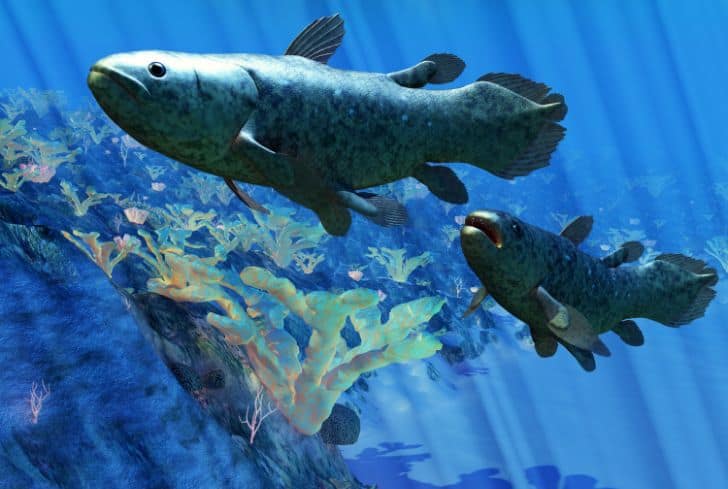
The coelacanth is an enormous, elusive, deep-sea fish that can live up to 100 years.
The distinctive feature of the primitive fish is its pair of fleshy lobe fins which extend away from the body like legs.
These pseudo legs of coelacanth help the fish cruise deep into the ocean in an alternating movement, like a ‘trotting horse’ as experts from National Geographic put it. The walking style is no different from that of tetrapods.
Interestingly, scientists viewed Coelacanth as extinct until they discovered some living species in South Africa in 1938.
12. Shortnose Batfish
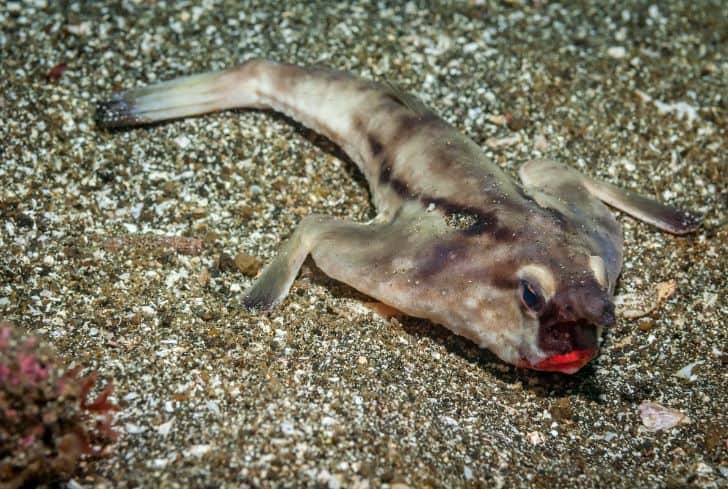
The Shortnose Batfish is a flat-bodied fish with a rounded triangular shape and a long pointed snout.
According to Mikey Charteris, a marine life expert, who photographed the fish in its unusual behaviors along Caribbean coastal waters, the shortnose slowly walks on the sea floor, searching for prey, including small fish and crabs.
The ventral fins of the strange fish have evolved to function as the front legs of four-legged creatures. And the pectoral fins, having receded to the rear part of the body, helps the fish walk, acting as hind legs.
13. Cave Angelfish

The Cave Angelfish is a tiny blind fish, usually about an inch and a half long.
Although tiny, the rare angelfish is not only made strange by its almost invisible eyes but thanks to its walking style that resembles some terrestrial vertebrates, particularly the salamander.
A study by a team of international scientists, as reported by Science News, found that the cave blind fish has evolved a robust pelvic girdle that enables the tiny creature to walk and climb, swinging itself from left to right.
14. Asian Hillstream Loaches
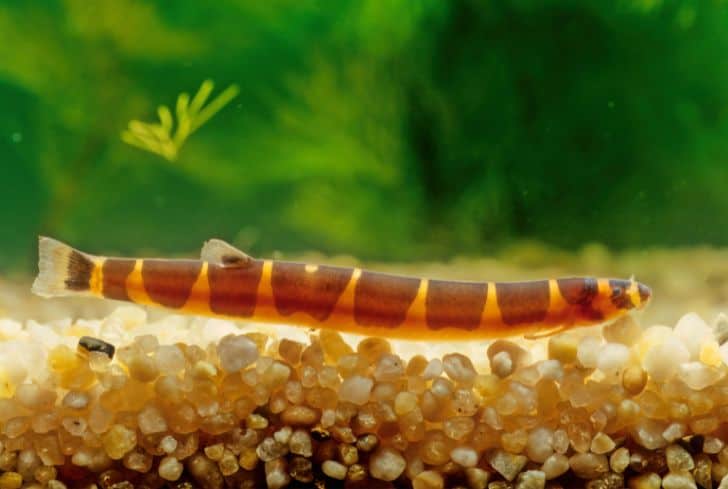
The Asian hillstream loaches are a family of tiny fish that like to cling to rocks in fast-moving tropical fresh waters. You can also find fish in aquariums, as fish enthusiasts love keeping the loaches as a hobby.
Asian Hillstream loaches are unique, as they’re the only fish with hip bones on all four fins.
But what’s more surprising is these tiny creatures can walk with all of their fins.
When they wish, they raise their bodies off the surface and walk with their pseudo legs in a Salamander-like style to mimic land-dwelling vertebrates.
They may not have the best walking style among the strange fish, but scientists believe the species with the most robust hip bones display the best walking ability.
15. Snakehead

Snakeheads are invasive fish with distinctive long dorsal fins.
Among the snakes that can live on land, snakeheads are some of the most strange. But only juveniles display the unusual ability of walking.
And surprisingly, they don’t use any of their fins, but their entire bodies. When they want to move from one pond to another pond, they walk by wiggling their long and slender bodies.
They can air-breathe to make them adapt to life outside water.


